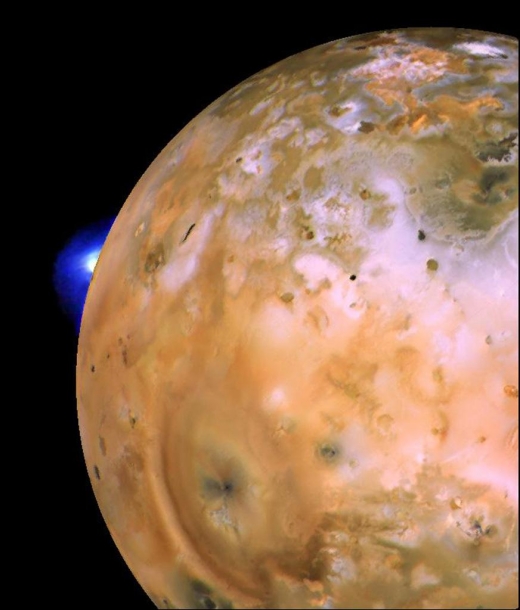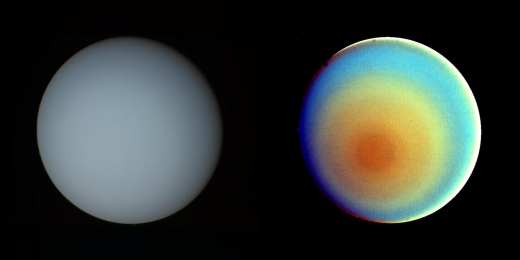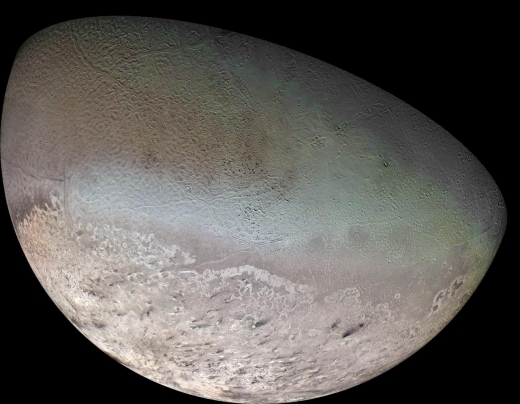It’s worth thinking about why Voyager 1 and 2, now coming up on their 40th year of operation, are still sending back data. After all, mission longevity becomes increasingly important as we anticipate missions well outside the Solar System, and the Voyagers are giving us a glimpse of what can be done even with 1970’s technology. We owe much of their staying power to their encounters with Jupiter, which demanded substantial protection against the giant planet’s harsh radiation, a design margin still used in space missions today.
The Voyagers were the first spacecraft to be protected against external electrostatic charges and the first with autonomous fault protection, meaning each spacecraft had the ability to detect problems onboard and correct them. We still use the Reed-Solomon code for spacecraft data to reduce data transmission errors, and we all benefited from Voyager’s programmable attitude and pointing capabilities during its planetary encounters.
Pioneer 6 was a doughty vehicle, but Voyager 2 (launched before Voyager 1) passed its record as longest continuously operating spacecraft back in August of 2012, while Voyager 1 eclipsed Pioneer 10’s distance mark in 1998 and is now traveling some 21 billion kilometers out. Voyager 1 is our sole spacecraft to leave the heliosphere, though Voyager 2 is expected to follow it in a few years, and we’ve already acquired important information, such as the fact that cosmic rays are four times more abundant in interstellar space than near the Earth.
You can see how all this begins to build the foundation for a ‘true’ interstellar mission, by which I mean one designed solely for the purpose of penetrating the local interstellar medium and reporting data from it. The heliosphere, Voyager has shown us, wraps around our Solar System and helps to provide a radiation shield for the planets. Missions both robotic and manned will need to be designed around the cosmic ray issues Voyager has uncovered.

Image: Voyager 1 image of Io showing active plume of Loki on limb. Heart-shaped feature southeast of Loki consists of fallout deposits from active plume Pele. The images that make up this mosaic were taken from an average distance of approximately 490,000 kilometers. Credit: NASA/JPL/USGS.
Still thinking interstellar, the Voyagers are telling us about the solar wind’s termination shock, that region where charged particles from the Sun slow to below the speed of sound as they push out into the interstellar medium — these are Voyager 2 measurements. Voyager 1 has measured the density of the interstellar medium as well as magnetic fields outside the heliosphere. The final benefit: We’ll have Voyager 2 outside the heliosphere while still in communication, so we can sample the interstellar medium from two different locations.
I always think of long spacecraft missions in terms of the people who work on them. Voyager is pushing on the ‘lifetime of a researcher’ rubric that some consider essential (though I disagree), the notion that missions have to be flown so that those who worked on them can see them through to destination. But of course the Voyagers have no destination as such; they’ll press on in a galactic orbit that takes fully 225 million years to complete. And as our spacecraft get even more rugged and capable of autonomy, we’ll soon take it as a given that multiple generations will be involved in seeing any complex mission through to completion. (See Voyager to a Star for my riff on a symbolic ‘extension’ to the Voyager mission).

Image: These two pictures of Uranus — one in true color (left) and the other in false color — were compiled from images returned Jan. 17, 1986, by the narrow-angle camera of Voyager 2. The spacecraft was 9.1 million kilometers from the planet, several days from closest approach. The picture at left has been processed to show Uranus as human eyes would see it from the vantage point of the spacecraft. Credit: NASA/JPL.
We have, according to the Jet Propulsion Laboratory, perhaps until 2030 before data from the Voyagers ceases. Each spacecraft contains three radioisotope thermoelectric generators (RTGs) running off the decay of plutonium-238. And as this JPL news release reminds us, with the spacecraft power decreasing by four watts per year, engineers have to be creative at figuring out how best to squeeze out data results under extreme power constraints.
For a mission this long, that means consulting documents written decades ago and at a completely different stage of technological development.
“The technology is many generations old, and it takes someone with 1970s design experience to understand how the spacecraft operate and what updates can be made to permit them to continue operating today and into the future,” said Suzanne Dodd, Voyager project manager based at NASA’s Jet Propulsion Laboratory in Pasadena.

Image: Global color mosaic of Triton, taken in 1989 by Voyager 2 during its flyby of the Neptune system. Triton is one of only three objects in the Solar System known to have a nitrogen-dominated atmosphere (the others are Earth and Saturn’s giant moon, Titan). The greenish areas include what is called the cantaloupe terrain, whose origin is unknown, and a set of “cryovolcanic” landscapes apparently produced by icy-cold liquids (now frozen) erupting from Triton’s interior. Credit: NASA/JPL/USGS.
It’s been quite a ride. Voyager discovered Io’s volcanoes and imaged rings around Jupiter, Uranus and Neptune, while finding hints of the apparent ocean within Europa that carries so much astrobiological interest. Between them, the Voyagers found a total of 24 new moons amongst the four planets they visited, detecting lightning on Jupiter and a nitrogen-rich atmosphere at Titan, the first to be found outside the Earth itself. And who can forget that bizarre terrain on Triton, or the tortured surface of Uranus’ moon Miranda?
“None of us knew, when we launched 40 years ago, that anything would still be working, and continuing on this pioneering journey,” said Ed Stone, Voyager project scientist based at Caltech in Pasadena, California. “The most exciting thing they find in the next five years is likely to be something that we didn’t know was out there to be discovered.”

Image: The Voyagers outbound. A representation of the heliosphere, including the termination shock (TS), the heliopause and the interstellar medium where the heliosphere ends. Credit: Science, NASA/JPL-California Institute of Technology. Note: In this image, the locations of the Voyagers are updated only to September 2011, by Brad Baxley, JILA.
Who knew that Voyager’s measurements of solar wind plasma, low-frequency radio waves, charged particles and magnetic fields would still be informing us fully forty years on? The next spacecraft to cross the heliosphere after Voyager, this time designed for just that purpose, will surely live even longer, challenging our conceptions of human achievement across generations and our willingness to tackle projects involving not just deep space but deep time.
This mission isn’t over. Go Voyager.



Popular Science coverage of Voyager 1 launch in 1977:
http://www.popsci.com/voyager-1-launch
But exercising the Uranian option means giving up a second close look at Titan and a second ring occultation. Even so, the initial planning all points toward Uranus: To avoid possible damage earlier in the mission, the Uranus candidate is targeted well away from Jupiter’s radiation dangers.
What will happen if one Voyager is lost, through a booster or spacecraft malfunction?
“I don’t know,” admitted Casani, “but there’ll be a lot of pressure on us to compromise the Saturn mission in order to visit Uranus.”
Mission planner Charles Kohlhase considered the possibilities. “If we’re going to give up anything at Saturn, we’d better be sure we’ve got a spacecraft healthy enough to give us Uranus.”
But even Uranus isn’t the end. That Voyager could go on to Neptune, reaching it in 1989. Then it, too, will head for the stars.
And somewhere out there, perhaps as it passes through some distant galaxy, Voyager 1 or 2 may provide one final surprise. For affixed to each Voyager is a metal master of a phonograph record. The record’s contents, selected by a team headed by Carl Sagan, includes classical music, natural and man-made sounds, and enough scientifically coded data to let some other civilization learn something about earth and earthlings.
Charles Kohlhase pondered the Voyager mission and its long-term implications: “To do everything, there are a lot of trade-offs,” he said. “But it’s really a training period for star travel.”
Voyager: The Space Between
Explore the universe and discover our home planet with the official NASA Tumblr account…
https://nasa.tumblr.com/post/165007695269/voyager-the-space-between
Pasadena 9/28: Voyager Golden Record panel with Ann Druyan, Reggie Watts, Lynda Obst, Ed Stone, and David Pescovitz…
https://boingboing.net/2017/09/20/pasadena-928-voyager-golden.html
To quote:
I’m honored to be included on a free panel discussion next Thursday, 9/28, at Caltech about the cultural influence of the Voyager Golden Record, the enchanting phonograph record launched into space on the twin Voyager spacecraft 40 years ago.
Rare Voyager mission item to be displayed at Cornell
Matt Weinstein, Published 11:33 p.m. ET Oct. 15, 2017 | Updated 12:35 p.m. ET Oct. 16, 2017
Cornell is celebrating the 40th anniversary of the Voyager spacecraft launch with a three-day multimedia exhibition this weekend highlighted by a rare Golden Record cover never before put on public display.
The Golden Record covers were used to protect the records and include iconic instructions for extraterrestrials on how to play them. The cover was lent to Cornell courtesy of Ann Druyan, who is the creative director of NASA’s Voyager Interstellar Message.
The exhibition is open from 9 a.m. to 5 p.m. Thursday and Friday and from 11 a.m. to 5 p.m. Saturday in Kroch Library. Druyan and others who worked on Voyager will discuss the mission in a panel on Thursday at 8 p.m. in Bailey Hall. All the events are free to the public.
http://www.ithacajournal.com/story/news/local/2017/10/15/rare-voyager-mission-item-displayed-cornell/766830001/
David Pescovitz / 11:38 am Tue Oct 17, 2017
Voyager Golden Record celebration at Cornell University this week
https://boingboing.net/2017/10/17/voyager-golden-record-celebrat.html
Cornellians celebrate the Voyagers’ historic Golden Record
By Blaine Friedlander
October 23, 2017
Four decades after NASA’s twin Voyager spacecraft launched from Cape Canaveral, about 800 Cornellians gathered at Bailey Hall Oct. 19 to celebrate the unprecedented mission, its famous Golden Record and the university’s role in the mission.
A panel focused on the Golden Record – a 12-inch, gold-covered copper record containing salutations to the universe, international music and images of life on Earth – that was affixed to the Voyagers so aliens could grasp something about our world. The record’s shelf life: 1 to 5 billion years.
Full article here:
http://news.cornell.edu/stories/2017/10/cornellians-celebrate-voyagers-historic-golden-record
To quote:
Looking to the future, the panelists suggested how humanity might explore space. Kaltenegger proposed expanding searches for exoplanets, while Squyres advocated obtaining Mars samples and taking them apart, “molecule by molecule,” to see if there is life there. Druyan urged study of the moons Enceladus and Europa, while Drake suggested sending a spacecraft to visit the focal point of the sun to use the sun as a gigantic lens. “The aim is to see other planets and the continents, and whatever else is there – we need to do that,” he said.
The Farthest is being shown again on PBS Television on November 15:
https://arstechnica.com/science/2017/11/set-an-alert-do-not-miss-the-farthest-on-pbs/
NASA launched this record into space in 1977. Now, you can own your own copy
By Travis M. Andrews, (c) 2017, The Washington Post
http://www.orlandosentinel.com/news/space/go-for-launch/os-nasa-launched-this-record-into-space-in-1977-now-you-can-own-your-own-copy-20171128-story.html#nws=true
To quote:
The real question was what to put on it.
“I remember sitting around the kitchen table making these huge decisions about what to put on and what to leave off,” Druyan said. “We couldn’t help but appreciate the enormous responsibility to create a cultural Noah’s Ark with a shelf life of hundreds of millions of years.”
They chose each track for a different purpose.
Some are obvious. The 12-minute audio essay fittingly titled “The Sounds of Earth” filled with sounds of everything from waves, laughter, an earthquake, crickets, chimpanzees, thunder, rain, footsteps, a baby’s cry and the wet smack of a kiss – to name a few – offered a short glimpse into the natural sounds we encounter here on Earth.
Others were more practical. The records included three compositions by J.S. Bach and two by Ludwig van Beethoven. The composers were given so much space in case the potential extraterrestrial life-forms were unable to hear the music, but could feel its vibration, Ferris noted in the New Yorker.
He wrote:
“To understand why we did this, imagine that the records were being studied by extraterrestrials who lacked what we would call hearing, or whose hearing operated in a different frequency range than ours, or who hadn’t any musical tradition at all. Even they could learn from the music by applying mathematics, which really does seem to be the universal language that music is sometimes said to be. They’d look for symmetries – repetitions, inversions, mirror images, and other self-similarities – within or between compositions.”
…
Despite the passage of time [40 whole Earth years, gasp!], the Voyager records should still be in perfect condition, according to NASA. But, of course, it’s impossible to know if it will ever be heard by any extraterrestrial life.
“I’d say it’s as fresh and new as the day it was placed aboard the spacecraft,” David Doody, an engineer on the Voyager mission at NASA’s Jet Propulsion Laboratory, told the Atlantic. “It’s been stored in a vacuum more perfect than any attainable on Earth, and protected from dust and cosmic rays by an aluminum metal case.”
Doody guessed the records “would be in playable condition for many hundreds of millennia.”
NASA’s Golden Voyager Record gets first vinyl release
By Miles Bowe, November 21, 2017
http://www.factmag.com/2017/11/21/nasa-golden-voyager-record-sagan-vinyl-release-reissue/
Copies of the record were placed in both Voyager spacecrafts, but never officially released to the public until now. Light In The Attic has detailed the 40th anniversary reissue which is available in a 2xCD or 3xLP boxset. The fully remastered set also includes a 96-page book with photographs and new liner notes from original producer Timothy Ferris.
The Golden Voyager Record is out December 1 on CD and next February on vinyl via Ozma Records. Order it and learn more via Light In The Attic and take a look at pictures from the set below.
https://lightintheattic.net/releases/3747-the-voyager-golden-record
NASA JPL News | December 1, 2017
Voyager 1 Fires Up Thrusters After 37 Years
If you tried to start a car that’s been sitting in a garage for decades, you might not expect the engine to respond. But a set of thrusters aboard the Voyager 1 spacecraft successfully fired up Wednesday after 37 years without use.
Voyager 1, NASA’s farthest and fastest spacecraft, is the only human-made object in interstellar space, the environment between the stars. The spacecraft, which has been flying for 40 years, relies on small devices called thrusters to orient itself so it can communicate with Earth. These thrusters fire in tiny pulses, or “puffs,” lasting mere milliseconds, to subtly rotate the spacecraft so that its antenna points at our planet. Now, the Voyager team is able to use a set of four backup thrusters, dormant since 1980.
“With these thrusters that are still functional after 37 years without use, we will be able to extend the life of the Voyager 1 spacecraft by two to three years,” said Suzanne Dodd, project manager for Voyager at NASA’s Jet Propulsion Laboratory, Pasadena, California.
Full article here:
https://www.jpl.nasa.gov/news/news.php?release=2017-310
To quote:
“The Voyager flight team dug up decades-old data and examined the software that was coded in an outdated assembler language, to make sure we could safely test the thrusters,” said Jones, chief engineer at JPL.
News | December 1, 2017
The Voyagers in Popular Culture
Whether you’re traveling across cities, continents or even oceans this holiday season, there is no long-haul flight quite like that of the Voyagers.
This year, we celebrated 40 years since the launch of NASA’s twin Voyager probes — the two farthest, fastest spacecraft currently in operation. Each Voyager has contributed an enormous amount of knowledge about the solar system, including the unexpected diversity of its planets and their moons. Among their many distinctions, Voyager 1 is the only spacecraft to enter interstellar space, and Voyager 2 is the only spacecraft to fly by all four giant planets: Jupiter, Saturn, Uranus and Neptune.
Full article here:
https://www.jpl.nasa.gov/news/news.php?feature=7015&utm_source=iContact&utm_medium=email&utm_campaign=NASAJPL&utm_content=daily20171201-1
How the Voyager missions and the Golden Record can help put things in perspective in a less than idyllic world, or I should say human society. The world just is as it is:
https://www.brainpickings.org/2017/12/21/reflection/